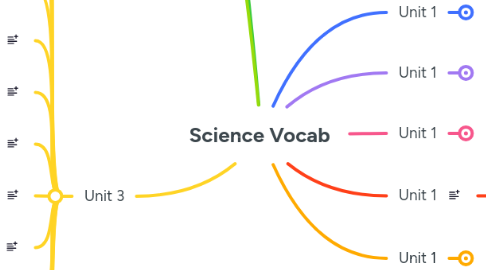
1. Unit 2
1.1. Magnet
1.2. Ferromagnetic Elements
1.3. Magnetic Force
1.4. Magnetic Poles
1.5. Magnetic Fields
1.6. Compasses
1.7. Magnetic Strength
1.8. Magnetic Potential Energy
1.9. Magnetic Domain
1.10. Nonmagnetic Materials
1.11. Magnetic Materials
1.12. Temporary Magnet
1.13. Permanent Magnets
1.14. Charges
1.15. Electric Fields
1.16. Electric Field Strength
1.17. Electric Potential Energy
1.18. Electrically charged objects
1.19. Electrically Neutral
1.20. Electric Insulator
1.21. Electric Conductor
1.22. Conduction
1.23. conservation of charge
1.24. Simple Circuit
1.25. Closed Circuit
1.26. Open Circuit
1.27. Charged Particles
1.28. Electric Current
1.29. Voltage
1.30. Energy
1.31. Electromagnetism
1.32. Electric Current
1.33. Magnetic Fields
1.34. Increasing Magnetic Field Strength
1.35. Controlling electromagnets
1.36. Electric Motor
1.37. Generating Electric Current
1.38. Electric Generator
1.39. Mechanical to electric energy
1.40. Direct Current
1.41. Alternating Current
2. Unit 3
2.1. Wave
2.2. Vibration
2.3. Tranverse Wave
2.4. Mechanical Wave
2.5. - Water waves
2.6. Mediums
2.7. Longitudinal Waves
2.8. Wavelength
2.9. - Sound Waves
2.10. Amplitude
2.11. Intensity
2.12. Decibel
2.13. Frequency
2.14. Pitch
3. Unit 3
3.1. Light
3.2. Radiant Energy
3.3. Light energy
3.4. Light brightness
3.5. Speed of light
3.6. Light sources
3.7. Transparent
3.8. Translucent
3.9. Opaque
3.10. Reflection
3.11. Law of Reflection
3.12. Virtual image
3.13. Concave mirrors
3.14. Focal Point
3.15. Convex Mirror
3.16. Real image
3.17. Regular reflection
3.18. Diffuse Reflection
3.19. Scattering
4. Unit 1
4.1. Lesson 1
4.1.1. Uniformitarianism
4.1.2. Absolute Age
4.1.3. Relative Age Dating
4.1.4. Sediment
4.1.5. Strata
4.1.6. Relative Age
4.1.7. Superposition
4.1.8. Original Horizontality
4.1.9. Lateral Continuity
4.1.10. Inclusions
4.1.11. Cross Cutting Relationships
4.1.12. The fossil record
5. Unit 1
5.1. Lesson 2
5.1.1. Unconformities
5.1.2. Angled unconformity
5.1.3. Disconformity
5.1.4. Nonconformity
5.1.5. Correlation
5.1.6. Key Bed
5.1.7. Geologic Time Scale
5.1.8. Index fossils
6. Unit 1
6.1. Lesson 1 M2
6.1.1. James Watson
6.1.2. Francis Crick
6.1.3. Rosalind Franklin
6.1.4. Double Helix
6.1.5. DNA
6.1.6. Nucleotide
6.1.7. Nitrogenous Base
6.1.8. Adenine
6.1.9. Guanine
6.1.10. Thymine
6.1.11. Cytosine
6.1.12. Genome
6.1.13. DNA Replication
6.1.14. Helicase
6.1.15. Primase
6.1.16. DNA polymerase
6.1.17. Semi-Conservative Replication
6.1.17.1. after one round of replication, every new DNA double helix would be a hybrid that consisted of one strand of old DNA bound to one strand of newly synthesized DNA.
6.1.18. Replication Fork
6.1.19. Leading Strand
6.1.20. Laggin Strand
6.1.21. Ligase
6.1.22. Mutations
6.1.23. Cancer
6.1.24. RNA
6.1.25. Uracil
6.1.26. Gene
6.1.27. Transcription
6.1.28. mRNA
6.1.29. Ribosomes
6.1.30. Translation
6.1.31. Amino Acids
6.1.32. Codons
6.1.33. Anti-Codons
6.1.34. tRNA
6.1.35. Peptide Bonds
7. Unit 1
7.1. Module 2
7.1.1. Charles Darwin
7.1.2. Galapagos Islands
7.1.3. HMS Beagle
7.1.4. Darwins Finches
7.1.4.1. They are well known for their remarkable diversity in beak form and function.
7.1.5. Natural Selection
7.1.6. Survival of the fittest
7.1.7. Adaptations
7.1.8. Fitness
7.1.9. Genetic Variation
7.1.10. Common Ancestors
7.1.11. Structural adaptation
7.1.12. Behavioral adaptation
7.1.13. Functional adaptation
7.1.14. Camouflage
7.1.15. Mimicry
7.1.16. Modern Theory of Evolution
7.1.17. Artificial Selection
7.1.18. Selective Breeding
7.1.19. Genetic Engineering
7.1.20. Recombinant DNA
7.1.21. GMO's
7.1.22. Gene Therapy
8. Unit 1
8.1. Noncontact Force
8.1.1. Newtons 3rd law of motion- for every action there is an equal and opposite reaction
8.1.2. Force Pairs- one member of which acts on one object, and one member of which acts on the other object
8.1.3. Normal Pairs- the force that surfaces exert to prevent solid objects from passing through each other
8.1.4. Collision forces- equal in magnitude and opposite in direction
8.1.5. Elastic Collision- a collision in which there is no net loss in kinetic energy in the system as a result of the collision like bowling
8.1.6. Inelastic collision- a collision in which there is a loss of kinetic energy
8.1.7. Unbalanced Forces- When the resultant force acting on a body is not equal to zero
8.1.8. balanced forces- forces that are equal in size and opposite in direction
8.2. Gravitational Force
8.3. Gravitational Field
8.4. Gravitational Force and Mass
8.5. Gravitational Force and Distance
8.6. Gravity in our solar system
8.7. Gravitational Acceleration
8.8. Weight
8.9. General Relativity
8.10. Reference Point
8.11. Position
8.12. Displacement
8.13. Speed
8.14. Average Speed
8.15. Velocity
8.16. Vector
8.17. Distance Time Graphs
8.17.1. acceleration- F = ma, or net force is equal to mass times acceleration
8.17.2. forces- an object will not change its motion unless a force acts on it
8.17.3. contact force- any force that occurs as a result of two objects making contact with each other
8.17.4. Newtons 2nd law of motion- the acceleration of an object is directly related to the net force and inversely related to its mass
8.17.5. friction- the resistance that one surface or object encounters when moving over another
8.17.6. free body diagram- are diagrams used to show the relative magnitude and direction of all forces acting upon an object in a given situation
8.17.7. net force- the sum of all the forces acting on an object
8.17.8. Newtons 1st Law of motion- An object at rest remains at rest, or if in motion, remains in motion at a constant velocity unless acted on by a net external force.
